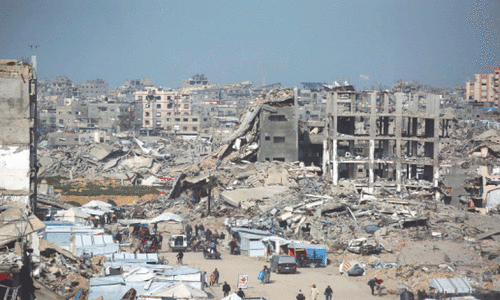PICK up any Urdu textbook and the chances are that it will endorse the following myths (a) the term 'Urdu' means military camp. Our language is called 'Urdu' because it was created in the army camps of the Mughals especially during the reign of Shah Jahan; (b) Urdu is a mixed language (
khitchri zubaan); (c) Urdu is a Muslim language.
Now let us deal with these myths one by one.
All the histories in Persian about medieval India use the Turkish word 'Urdu' (which means 'camp' in original Turkish) for 'city'. The word is not used in the original Turkish meaning in Indian sources in Persian for the most part. Sometimes the terms 'Urdu-i-mualla'and 'Urdu-i-badshahi' are also used. During Shah Jahan's time, Urdu-i-mualla referred to the language spoken in the city of Shahjahanabad (Delhi).
The language we now call Urdu has an ancestor referred to as Hindvi and Hindi in most medieval Persian sources. In Gujrat, however, the language is called Gujri and sometimes Gujrati. In the Deccan it is called Dakani and around the Delhi area it is also called Dehlavi. During the 18th century the word 'Rekhta' was also used for it.
Meanwhile the British, and also some other outsiders, call it Indostan, Moors and then Hindustani. In fact, the name 'Hindustani' was used so much by the British that both Muslim and Hindu scholars often used it themselves for their common heritage during the 1930s and 1940s.
Syed Sulaiman Nadwi and some other thinkers who wanted Hindu-Muslim unity in British India even suggested that the term 'Urdu' be abandoned in favour of 'Hindustani' because the former conjured up the image of a military conquest and war whereas the latter had no such symbolic baggage.
The word 'Urdu' is a contraction of the phrase 'zubaan-i-Urdu-i-mualla' (i.e. the language of the exalted city) which came to be used during the late 18th century. It is, in fact, the most recent name for a language which certainly existed even in the 13th century. There are words and sentences which we can recognise even today in the malfuzat (sayings) and tazkiras (biographies) as well as other records of that period. They refer to the language used in the marketplace, songs, conversation and in homes. The military reference does not exist though the language must have been used among soldiers also.
It was certainly used in religious circles because even in far-off Kaniguram in Waziristan, a religious reformer called Bayazid Ansari wrote a book called Khairul Bayan in 1560 which has over 16 lines in this language which the author calls Hindi.
Now for the myth that Urdu is a mixture of other languages. If a language is really a mixture it is called pidgin which is nobody's mother tongue and a reduced language. It may become a creole when it is developed and becomes somebody's mother tongue.
Urdu's ancestor — call it what you will — existed in India (probably in the vicinity of Delhi) as a full language. Words of Persian and Arabic origin crept into it. This was not because of military activities but ordinary everyday interaction.
This is a natural process and modern English came about in exactly this manner. That is why about half the vocabulary of English is from Latin and Greek via Norman French. But English is not called a 'mixed language' so why should Urdu be stigmatised as such?
If one starts calling languages mixed in the sense that there was no base for them and words from different languages combined then Urdu is not that kind of product. Urdu is mixed in the same way that English is it has absorbed words from many languages.The third myth that Urdu is a Muslim language is more problematic. For about 500 years of its existence nobody called it Urdu. It was called Hindi and had many words of Sanskrit origin as do other texts — until the 18th century.
Then a language reform movement initiated by Muslim poets (Hatim, Mirza Mazhar, Nasikh's students etc) threw out certain words from the corpus of the language. Among them were words like chinta (worry), prem (love), sundar (beautiful) etc. The movement was actually an attempt to create a linguistic marker for the cultural elite which was mostly Muslim. However, instead of being merely a class movement it became a religious one. Thus, Urdu was imbued with distinctive Perso-Arabic cultural content and served as an identity symbol for the Muslims of India.
In the same way, after 1802, modern Hindi was created by weeding out Persian and Arabic words and using only the Devanagari script for writing. These new languages — Sanskritised Hindi and Persianised Urdu — drifted apart from each other and still serve as identity markers for Hindu and Muslim nationalism in South Asia.
During the Pakistan Movement, Urdu became a symbol of the identity of South Asia's Muslims. It was invested with emotional force and Maulvi Abdul Haq, who used to term it a composite language while in India, started calling it the mainstay of Muslim separatism.
Similarly, Sanskritised Hindi became the symbol of the attempt to eliminate the share of Muslims in Indian culture. This political gulf between the two sister languages remains to this day — although at the spoken level, Urdu and Hindi remain the same language as all Indians who watch Pakistani dramas and all Pakistanis who watch Hindi movies will testify.
However, while Pakistani Muslims insist that Urdu is a Muslim language, the Muslims of India refer to it as a composite language. This is because it is in the political interests of Pakistani Muslims to emphasise the differences between themselves and the Indians while the opposite is in the political interests of Indian Muslims.
In short, Urdu means different things to different people. It is only by separating the myth from reality that we can appreciate its true nature.













































